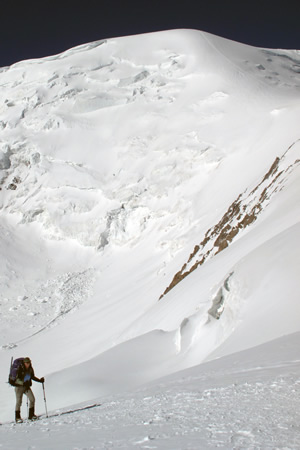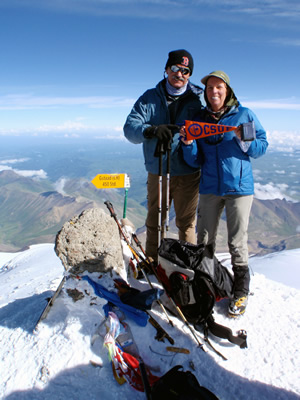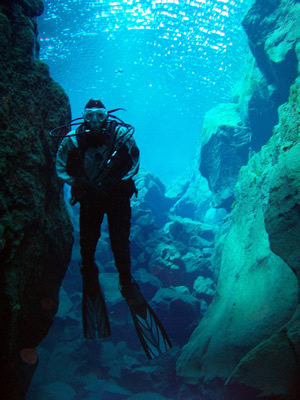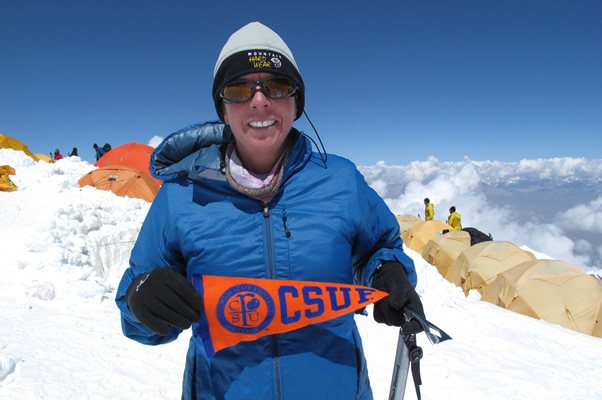Race to Mt. Everest
Lecturer Struck With Rare Disease Set to Reach Mountain Peak, Raise Awareness
December 15, 2009
By Mimi Ko Cruz
Cindy L. Abbott is in a big hurry.

Cindy L. Abbott ascending Peak Lenin. Photo by Scott Woolums
She must climb Mt. Everest while she’s still able. Abbott, a part-time health science lecturer, is losing her vision and her body is deteriorating.
She suffers from a fatal disease — Wegener’s Granulomatosis — that causes inflammation of blood vessels, restricting blood flow and damaging kidneys, lungs and other organs.
“I have this super rare disease,” Abbott said. “It started with loss of vision in my left eye. I was going blind and, for 10 years, no one could tell me why. I had a bunch of mini strokes and vertigo. It was a relief to finally be diagnosed in 2007.”
But, Wegener’s Granulomatosis has no cure.
“That’s why I want to climb Mt. Everest now,” Abbott said. “My immune system is down from the immunosuppressant medication I’m taking to control the disease and I don’t know how much longer I have. I want to live life to its fullest.”
The 50-year-old mountain climber-scuba diver-ballroom dancer also wants to raise awareness about her disease and other rare conditions in her quest to climb the highest mountain on Earth.
“I’m promoting rare disease awareness and collecting funding for research,” Abbott said, adding that she is working with the National Organization for Rare Disorders to have California proclaim Feb. 28 as Rare Disease Day. Thirty-nine other states recognized the day last year.
“I’m writing letters to Gov. Arnold Schwarzenegger and First Lady Maria Shriver to see if they will add California to the list in 2010,” Abbott said.
She also is raising money for the Vasculitis Foundation, a nonprofit organization that supports and empowers patients through education, awareness and research.
Abbott, who for decades has been traveling the world diving the deepest oceans and hiking the highest mountains, recently launched a website where she is blogging about her life, her disease, her Mt. Everest quest and her fundraising activities.
Climbing Mt. Everest is no lark for Abbott. She is a serious mountaineer who always desired to someday make the journey. Her disease, however, has expedited her wish, she said. "But, I don't have a death wish. I know I can do this."
To prepare for her ascent up the south side of Mt. Everest (29,029 feet), which straddles Tibet and Nepal, Abbott has been training by climbing other mountains. She’s reached the top of Mt. Baldy (10,064 feet) in California every weekend for the past few months. Her other treks include:
- Mt. Kilimanjaro (19,341 feet) in Tanzania in 2006
- Mt. Whitney (14,504 feet) in California in 2008
- Mt. Rainier (14,411 feet) in Washington in June
- Mt. Elbrus, (18,513 feet) in Russia in July
- Peak Lenin (22,500 feet) in Kyrgyzstan in August

Larry and Cindy Abbott, both Cal State Fullerton graduates, at the top of Mt. Elbrus in Russia. Photo by Scott Woolums
Last year, Abbott aborted her climb to the top of Mt. Aconcagua in Argentina at about 20,000 feet due to high winds. After descending 1,000 feet, she broke her leg but hiked down to base camp. She had surgery and was up, hiking again five months later.
She leaves for Everest April 1. She will fly to Katmandu, then to Lukla in Nepal before starting on a 10-day trek to base camp, which is at 17,500 feet.
Her guide, Scott Woolums, will lead her, three other women and a man on the expedition. They will train at base camp for three weeks before attempting to summit in mid-May.
Abbott, who is seeking sponsors for the equipment she will need, said she expects to return home June 4.
“She’s incredibly focused on this project,” Woolums said about Abbott. “She’s definitely capable of making it.”
Woolums, who has been Abbott’s guide on various hikes for three years, said that to attempt Mt. Everest, one must be physically and, more importantly, mentally prepared.
“Cindy is ready,” he said. “I think the experience will open her perception on her abilities, what she’s capable of.”
Kathy Koser, associate dean of the College of Health and Human Development, calls Abbott an inspiration.
“Your continual positive attitude and inner strength despite your medical setbacks is awesome,” Koser wrote on Abbott’s web site. “You are a great role model and example of overcoming obstacles and reaching one’s full potential.… You are showing the rest of us that it is less about the destination and more about the manner in which you travel.”

Cindy L. Abbott diving in 37-degree water in Iceland.
A fellow victim of Wegener’s Granulomatosis wrote: “Cindy: I am inspired and amazed that a fellow WG patient is able to reach for a dream and help so many doing it. You are a very special and giving person to be able to do this. My WG was found early and I have been grateful ever since. Getting to know how different all our cases are and their extremes are mind blowing. I have decided it is time for me to take care of myself and workout again because you have inspired me.… Thank you for sharing your story and inspiring many!”
Abbott and her husband, Larry Abbott, a retired Orange County Lieutenant sheriff who also teaches kinesiology classes on campus, run an income tax preparation business from their Irvine home and save up money to take exotic trips each year. They have a 28-year-old daughter, Teshia Ochoa-Abbott, a three-legged cat, Tiny, a one-eared cat, Patches, a kitten, Silfra, with no teeth and a one-eyed macaw, Chico.
“We adopted these pets because they needed somebody to care for them and love them,” Abbott said. “When I do my climb, I’ll miss my family. That’s the hardest part.”
She said she is cashing out her retirement savings to pay for her $80,000 trek.
“My husband is scared for me and feels helpless but he is so supportive, and so is my daughter,” Abbott said, adding that climbing Mt. Everest “is just something I have to do.”
“I want to stand up there and be at the top of the world,” she said. “It’s an amazing challenge that few women have tried and I know it will be hard physically and psychologically, but it will be worth it.”
Still, it’s a dangerous and difficult expedition. There are many accounts detailing treacherous treks to the summit and the statistics are slim: Between 1922 and 2004, 186 of 2,249 climbers died, according to EverestHistory.com. But, survivors often return with a new outlook on life and a sense of accomplishment.
“If I can conquer the challenge, I can do anything,” Abbott said.
When she graduated from Cal State Fullerton with her bachelor’s degree in physical education in 1993 and her master’s degree in kinesiology in 1996, she received the highest honors bestowed on students.
Her former professor and now colleague, Bill Beam, called her the best graduate assistant who ever ran the university’s exercise physiology lab.
“She was so organized and she enforced the rules,” Beam said, adding that he gets together with her family each year to check out photos from her worldly adventures.
“They take these incredible journeys,” he said. “Cindy is not letting her disease stop her. I know she’s had an interest in going to Mt. Everest for a long time and I think it’s a good idea. She’s always very positive and I think her web site will benefit people. I know if I got a rare disease, I’d want to know that money and awareness was being raised for ongoing research.”
That is the point, Abbott said.
“Too many people take life for granted and need to live life, not wait for life to come to them,” she said. “You need to reach for your dreams, no matter the obstacles.”


